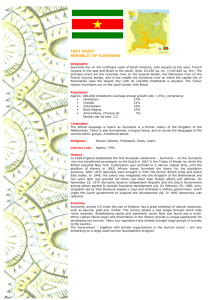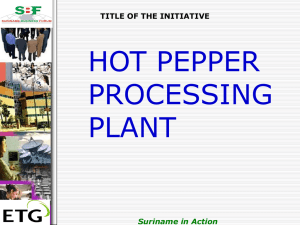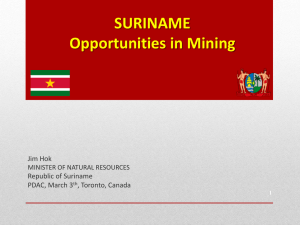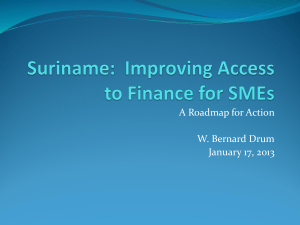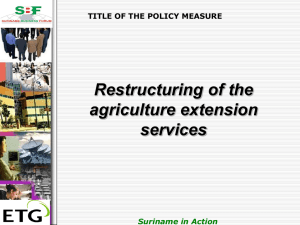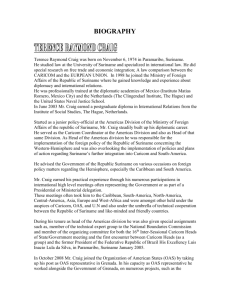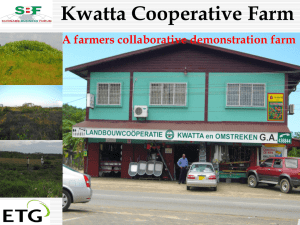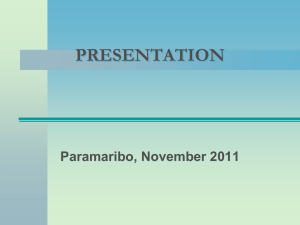Country Studies Series: Suriname - Heller School for Social Policy
advertisement
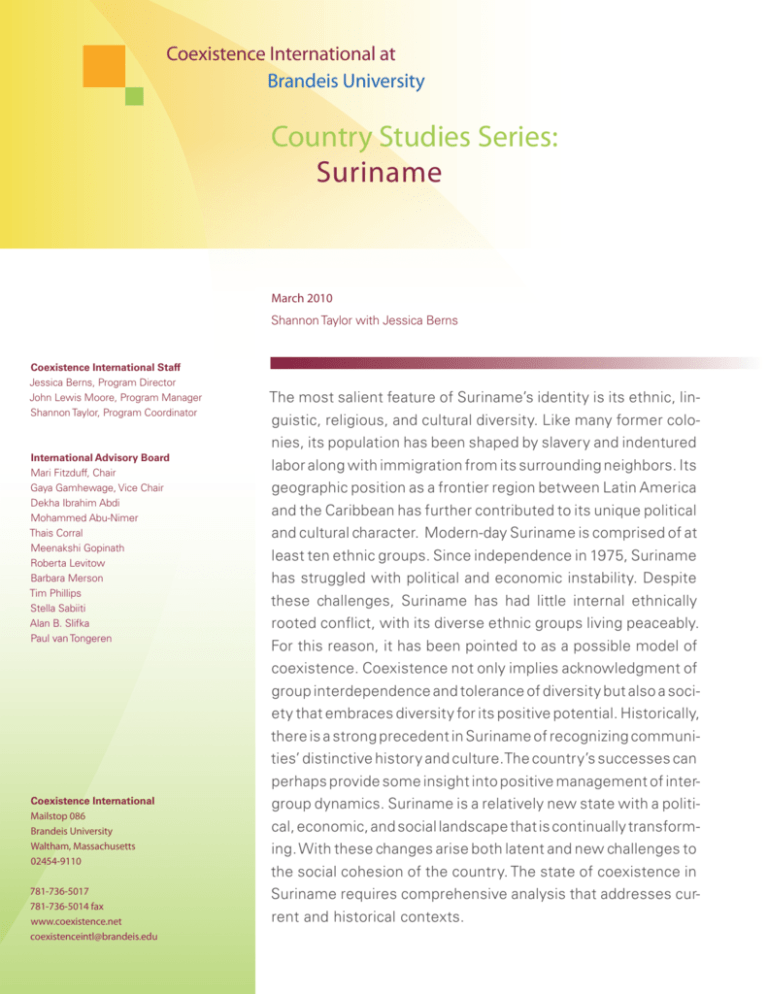
Coexistence International at Brandeis University Country Studies Series: Suriname March 2010 Shannon Taylor with Jessica Berns Coexistence International Staff Jessica Berns, Program Director John Lewis Moore, Program Manager Shannon Taylor, Program Coordinator International Advisory Board Mari Fitzduff, Chair Gaya Gamhewage, Vice Chair Dekha Ibrahim Abdi Mohammed Abu-Nimer Thais Corral Meenakshi Gopinath Roberta Levitow Barbara Merson Tim Phillips Stella Sabiiti Alan B. Slifka Paul van Tongeren Coexistence International Mailstop 086 Brandeis University Waltham, Massachusetts 02454-9110 781-736-5017 781-736-5014 fax www.coexistence.net coexistenceintl@brandeis.edu The most salient feature of Suriname’s identity is its ethnic, linguistic, religious, and cultural diversity. Like many former colonies, its population has been shaped by slavery and indentured labor along with immigration from its surrounding neighbors. Its geographic position as a frontier region between Latin America and the Caribbean has further contributed to its unique political and cultural character. Modern-day Suriname is comprised of at least ten ethnic groups. Since independence in 1975, Suriname has struggled with political and economic instability. Despite these challenges, Suriname has had little internal ethnically rooted conflict, with its diverse ethnic groups living peaceably. For this reason, it has been pointed to as a possible model of coexistence. Coexistence not only implies acknowledgment of group interdependence and tolerance of diversity but also a society that embraces diversity for its positive potential. Historically, there is a strong precedent in Suriname of recognizing communities’ distinctive history and culture.The country’s successes can perhaps provide some insight into positive management of intergroup dynamics. Suriname is a relatively new state with a political, economic, and social landscape that is continually transforming. With these changes arise both latent and new challenges to the social cohesion of the country. The state of coexistence in Suriname requires comprehensive analysis that addresses current and historical contexts. Shannon Taylor is the Program Coordinator for Coexistence International . She has spent the last six years working in the international development field primarily with education and youth development programs in the African region. Jessica Berns is the Program Director at Coexiestence International. Background The country of Suriname, formerly known as Dutch Guyana, geographically straddles Latin America and the Caribbean. The distinctive character of present-day Suriname has been shaped by its geographic position, along with its colonial history and environmental landscape. It is bordered by the Atlantic Ocean to the north, French Guiana to the east, Guyana to the west, and Brazil to the south. More than 75% of the country is rainforest.1 Suriname is the only Dutch-speaking country in Latin America, and while located nearly 500 miles east of the Caribbean Sea, it is still considered part of the Caribbean region. It is the smallest sovereign state in South America in terms of both land mass and population. As of July 2009, the population of Suriname was 481,267 in an area of 163, 270 km.2 It is divided into 10 districts comprising urban, peri-urban, and the interior area, with the largest population living in and around the capital of Paramaribo. Approximately 80% of the population is clustered into the coastal urban and peri-urban areas, while 20% of the population resides in the interior districts. The interior makes up 80% of the land area and is marked by vast tracts of rainforest.3 Suriname’s colonial history has contributed to creating a country rich in both ethnic and linguistic diversity. Suriname is a complex society composed of many ethnic groups, varying religious convictions, and at least 15 different spoken languages. The original indigenous populations, known as Amerindians, comprise 3.7% of the current population.4 Originally settled by the English, the Dutch traded New York to the English for the area known as present-day Suriname in 1667. Like its Caribbean neighbors, Suriname’s history is marked by slavery. With the onset of a plantation economy came the introduction of slave labor, with most of the slaves coming from Africa. The Creoles, one of the largest ethnic groups of modern-day Suriname, with 31% of the population,5 are descendents of these slave populations. During slavery, many African slaves escaped into the largely unpopulated interior to avoid the harsh working conditions. The descendents of these escaped slaves are the contemporary Maroon population and make up between 10-14%6 of the total population. The Maroons succeeded in establishing independent communities and have maintained a distinct culture based on both African and Amerindian traditions. Because of their historical background and distinct culture, Maroons are classified as an indigenous group. After slavery was outlawed, in 1863, the Dutch imported indentured labor from northern India, the Netherlands East Indies (Indonesia), and China to maintain plantation production. These populations were intended to return home after a ten-year period, but most remained in Suriname. The descendents of these populations comprise present day Hindustanis of Indian origin, the Javanese, and the Haka Chinese, respectively. The East Indian Hindustanis make up about 35% of the population, the Javanese 15%, and the Chinese 2%.7 There is a significant population of Brazilian immigrants (estimates range as high as 10% of the population). Other groups represented in present-day Suriname include Lebanese, Syrians, Jews, and those of European descent. Suriname Timeline 1667 1863 1954 1975 1980 1982 1986 1991 1992 Dutch acquire Suriname from the British Slavery abolition; indentured laborers from India, Indonesia, and China brought to Suriname Suriname obtains autonomy from the Dutch Suriname independence Military coup; military leader Desi Bouterse seizes power “The December Murders” The War of the Interior begins Civil rule returns, democratic elections held Peace Accords negotiated with the Surinamese Liberation Army ending the War of the Interior 1996 2005 Jules Wijdenbosch elected President 2007 The Saramaka Peoples Ruling by the Inter-American Court on Human Rights 2008 Trial begins of former dictator Desi Bouterse and others accused of the December murders 2010 National elections to be held New Front Coalition wins majority; Current President Venetiaan elected Suriname acquired autonomy from the Netherlands in 1954 but did not officially gain its independence until 1975. The Dutch presence persists to this day. While Suriname is linguistically diverse, Dutch remains its official language, and the economic and cultural ties to the Netherlands continue. Migration from Suriname to the Netherlands has been a continual trend since colonial times. Shortly before independence, however, Suriname experienced a dramatic upsurge in emigration prompted by concerns of instability as the country made the transition to an independent state. Between 1974-75, more than 50,000 Surinamese migrated to the Netherlands. Another substantial wave of migration to the Netherlands, approximately 30,000 people, occurred shortly before Suriname introduced visa requirements following independence, restricting movement between the two countries. It is estimated that 325,000 people of Surinamese origin live in the Netherlands.8 Furthermore, a large portion of the country’s development aid money is received from the Netherlands this has been true since independence, with the exception of a suspension of aid following the military coup of 1980. While Suriname’s transition to Independence was peaceful, the country has experienced both economic and political turmoil marked by a brutal military dictatorship from 1980-1990, a 6-year civil war in the interior of the country from 1986-1992, and economic inflation resulting from falling bauxite and aluminum prices, the main natural resources in the country. The period when Suriname was under military control was marked by gross human-rights violations, including violations of civil and political rights, most notably the “December Murders” in which 15 political opponents to the military government were executed. It was not until May 1991 that a democratically elected government resumed power in Suriname, followed in August 1992 by a peace agreement that ended the Interior War between the government and the Jungle Commandos, the Maroon opposition group, that ended the Interior War. Currently, Suriname enjoys a relatively high standard of living for the region, with a Gross Domestic Product (GDP) of US $7,722. According to the 2006 UNDP Human Development Report, it is ranked 89th out of 177 countries with and Human Development Index (HDI) index of 0.759, a composite statistic that includes education, GDP, and life expectancy indicators. Its ranking falls between some of its more wealthy Latin American neighbors, but is higher than its closest neighbor, Guyana.9 It has made considerable headway toward several of the Millennium Development Goals, namely universal primary education, decreasing child mortality, and combating HIV/AIDS.10 In addition, with its vast tracts of rainforest and wildlife as well as its impressive colonial architecture centered in the capital, the country has substantial unrealized potential for tourism. Despite this progress, 60% of the population remains below the poverty line.11 Suriname is struggling to overcome the deterioration of infrastructure that occurred during its years of political and economic crises, its inequitable distribution of wealth and economic opportunity between urban areas and the interior, and its unstable economy based largely on natural-resource extraction. Current State of Coexistence Suriname’s society is largely a nation of immigrants who arrived as settlers, slaves, and indentured laborers. Although the country’s past contains inequality, exploitation, and apartheid, modern Suriname has been remarkable for its relatively peaceful state of coexistence among ethnic and religious groups. Despite Dutch colonial rule which sought to divide the population along ethnic lines, and despite political division under the military dictatorship shortly following independence, the Interior War, a protracted battle between the then military dictatorship and Maroon groups living within the interior part of the country, was the only major incident of violent ethnic conflict in Suriname’s modern history. This is remarkable in a country of such diversity. While considered part of the Caribbean region, Suriname is differentiated from the larger Caribbean region by a greater degree of pluralism, a lesser emphasis on Creolization, and a large Asian population. Additionally, Suriname differs from its neighbors of the Guiana sub-region in in an important way: there is no one substantial ethnic majority in Suriname, creating a society with less polarization than its neighbors. The fact that no one group defines Suriname’s national identity is part of what has led to the country’s plural and a stable society. The mamio, a patchwork quilt, is often used as the unofficial symbol of Suriname’s variety of population groups and cultures.12 Diverse ethnic and linguistic compositions, weak governance, and lack of national identity are often identified as causes of social tension in nations, and in turn a hallmark of instability.13 Suriname has, instead, been able to capitalize on these features to build a stable and fluid society. Its loose organization and fragmentation have allowed easy shifts between political, economic, and social coalitions. Part of its success can be attributed to the fact that Suriname has embraced its plurality, accepting “bright rather than blurred” ethnic boundaries.14 In addition to its diverse and fluid demographic composition, several other key characteristics have contributed to the stability of Suriname’s multi-ethnic society. These include: 1) favoring a dominant plural ideology instead of a unifying nationalism, 2) political structure and leadership that has easily formed informal coalitions across parties, and 3) persistent transnational ties. National Identity Formation Despite several attempts throughout its history to promote a cohesive national identity, the resistance to a unifying nationalism has remained a salient feature of Suriname in both political and social contexts. The Dutch colonial policy was one of assimilation through universal education; it required the use of Dutch language, laws, and customs. The Javanese and Hindustani traditions proved too resistant and, in around 1930, the Dutch began to recognize Asian cultural traditions such as marriage practices.15 In later years, the Creole elite attempted to promote Creolization as a means of national identify formation. This too was met with resistance by other segments of the population.16 After independence, Suriname began to promote an integrated Surinamese identity, but this political platform lost popular support when the military regime associated with it began to commit human rights violations in its efforts to disempower rival political groups. this election voters elected eight Maroon candidates and one Amerindian candidate to the National Assembly, the highest representation of indigenous groups achieved in Suriname’s history.23 Out of this resistance to one common national identity has grown a shared common vision of society best described as “unity in diversity”.17 There is a prevailing mutual respect for a range of cultural and religious traditions among the Surinamese, with no one tradition attempting to promote cultural hegemony. This ideology in practice tends more toward the acceptance of cultural diversity rather than true political unity or social integration. Suriname maintains a truly transnational character, with common diasporic flows of the population and relatively porous borders. This feature contributes to a society with a plural nature. A survey conducted in 1992 of 4,000 households in the greater Paramaribo area revealed that 75% of the Surinamese population had relatives living in the Netherlands.24 As mentioned earlier, strong flows of immigration to the Netherlands has been a constant feature of Suriname, and the Surinamese diaspora extends to other countries well, including Indonesia and India. The economic remittances that result from these historical cultural ties form a substantial part of the economy, both formal and informal. In addition, the government of Suriname continues to value the cultural autonomy and connection to home land of its ethnic groups. For example, a 2006 speech by President Runaldo Ronald Venetiaan highlighted the significance of the cooperation between Indonesia and Suriname in the areas of education, culture, and trade.25 Political Structure Suriname’s modern political stability is often attributed to several factors unique to its political system and to its national vision. First, Suriname’s political roots are in consociational democracy. Consociationalism is a power-sharing system where each of the political groups or parties are too small to hold a majority position. Thus, there is maximum autonomy of groups, political power sharing, and proportional representation.18 Political parties divided along ethnic lines are the norm in Suriname. While latent tensions exist between Creoles and Hindustanis, they have not tended to manifest themselves in violence. This can largely be ascribed to strong political leadership early in the emerging government. As Suriname transitioned from an autonomous republic to a completely independent state, ethnic and political groups were able to rally together against the Dutch colonial power. Party leaders reached across party lines to form coalitions, including the New Front Coalition, with the goal of ensuring that one group was not overly represented in the leadership of the country.19 This philosophy of broederschap (brotherhood) is well respected in Suriname; it is based on an ideology that values the inclusion of many ethnic groups in leadership in order to avoid conflict or to resolve it in a peaceful manner.20 Finally, friendship and collaboration among political leaders is greatly valued as a non-institutionalized binding force between political parties. While in the past, political parties were created along ethnic lines, currently there is an increase in mixed political parties which share economic and social goals rather than identical ethnic backgrounds.21 The largest political party, the National Democratic Party (NDP), is not tied to any particular ethnic group. There has also been a movement to increase the representation of indigenous populations in public life. In 2003, the political organization SaMaDe (Cooperating Maroon Experts) was formed, with the goal of increasing Maroon representation in government. This was followed by the formation of a coalition of Maroon parties called A-Combinatie that resulted in three political parties with Maroon backgrounds along with one Amerindian party taking part in the 2005 elections. 22 During Immigration and Transnational Identity Porous borders add to the persistence of the population’s transnational character. As result of the Interior War, many Maroons migrated to neighboring French Guiana. There are said to be more Maroons living outside their traditional areas than within the Surinamese interior.26 Eastern Suriname is an example of a small multi-ethnic enclave that has emerged from easily permeable borders. That area has been experiencing a large wave of Brazilian migration, both legal and illegal, motivated by work in the gold industry as gold diggers, or garimpeiros. There are an estimated 40,000 Brazilians residing in Suriname, making up about 10% of the current population.27 Maroons and Brazilians manage to peacefully coexist in eastern Suriname, maintaining their cultural identity. A division of labor in the gold industry easily emerged, with the Maroon population acting as land owners and the Brazilian garimpeiros specializing in technology and labor. Economic relationships, social relationships, and marriage are the rule rather than the exception in this region.28 Religion Suriname’s high degree of religious tolerance is unusual as compared to many other countries with similar diversity. In Suriname, there are various religions including Hinduisim, Christianity, Islam, and Judaism, and the constitution protects the right to “freedom of religion and philosophy of life.”29 Twenty percent of Suriname’s population is Muslim, the highest percentage of any country in the Americas.30 As a result of the multiplicity of religions, the government recognizes several religious days as national holidays, indicating a respect for the diversity of religions represented in the country. Since 1992, the government has supported an inter-religious council composed of representatives of various religions. They meet twice monthly to coordinate interfaith activities and discuss government positions and policies.31 This institution has been instrumental in bringing solutions to major national political impasses32 and is currently involved in poverty intervention, inter-cultural dialogue, and initiatives that address crime and violence. In this way, religion in Suriname has been a binding force rather than a source of contention. It is often noted that on one of the main streets of Paramaribo, a Jewish synagogue and mosque are located next to each other, a symbolic testament to the tolerance and religious openness between groups in Suriname.33 Language Language is perhaps one of the most complex aspects of the Surinamese social mosaic. Its intricacy derives from the number of languages spoken combined with the uses and contexts to which they are put. Dutch continues to be the official language of Suriname, but Sranan Tongo—a mixture of Dutch, English, and African languages—is the lingua franca and is employed in every day life. A developing body of literature is written in Sranan Tongo. English is widely spoken and is a mandatory part of the curriculum in middle and high school.34 In addition, there are three Asian languages spoken in Suriname—Saranami Hindi, Surinamese Javanese, and Hakka Chinese; two Maroon languages—Auka and Saramaka; and six Ameridian languages— Akurio, Carib, Trio, Wayana, Warao, and Arowak. An influx of Brazilian immigrants has increased the prevalence of Portuguese.35 There are media outlets in Dutch, English, and Sranan Tongo, and sign postings can be seen in all these languages as well as in Hindi and Portuguese. This sustained multilingual society has persisted, in part, because of strong ties to countries of origin. Policies and Initiatives Human Rights Suriname is party to the following international human-rights instruments: the International Covenant on Civil and Political Rights (ICCPR); the International Covenant on Economic, Social and Cultural Rights (ICESCR); the International Convention on Elimination of All Forms of Racial Discrimination (CERD); the Convention on Elimination of All Forms of Discrimination against Women (CEDAW); and the Convention on the Rights of the Child (CRC). The constitution of Suriname incorporates the human-rights definitions delineated by these treaties. It gives a good degree of attention to personal rights and freedoms (in Chapter V) as well as economic, social, and cultural rights (in Chapter VI). Chapter VI, for example, contains the following: [The] right to humane conditions and secured means of livelihood, the right to free primary education, the sharing of everyone in economic, social, cultural development progress, the equitable distribution of national income; and the right to health and protection of family and child.36 Article 8 of the constitution prohibits discrimination “on the grounds of birth, sex, race, religion, origin, education, political convention, economic position or social conditions or any other status”.37 Articles 10, 11, and 12 guarantee an equal, public, and timely remedy of complaint in case of violation of rights and freedoms. The definition of racial discrimination is also present in the criminal code. The government of Suriname in general respects the human rights of its citizens; however, the Surinamese judiciary cannot require the government to adopt or amend legislation. This is the exclusive domain of the National Assembly.38 Thus, means of remedy to violations of rights are slow or non-existent. A parliamentary commission on human rights operates throughout the year. However, its effectiveness is impeded by resource constraints.39 There is an emerging human-rights culture largely centered on protecting, promoting, and empowering the rights of indigenous groups, minorities, women, and children. While civil society organizations are allowed to operate freely, it has been noted that there is a degree of self-censorship among civil-society organizations because of the patron-client system by which the government operates. There continue to be problems surrounding the issues of civil and political rights, including police mistreatment of detainees and prisoners, overcrowded detention facilities, a backlogged and slow-moving judiciary system, and corruption in the government. Currently, Desi Bouterse, who led the military coup and ruled Suriname from 1980 until 1987, is standing trial, along with 24 other co-suspects, in Paramaribo for the “December Murders” of 15 prominent citizens, opposition military leaders, journalists, lawyers, and academics.40 Suriname has been subject to two rulings by the Inter-American Human Rights Court with regard to indigenous rights. The first, in 2005, the Moiwana Village Case, involved the massacre of at least 40 innocent N’djuka Maroon civilians by the military in 1986. The second ruling, in 2007, the Saramaka People Case, deals with the failure of Suriname to legally recognize the communal land ownership of the Saramaka communities.41 In both these cases, Suriname was found to be responsible for serious, institutionalized, and long-standing violations of indigenous rights. Indigenous and Minority Groups In Suriname, Amerindian groups and Maroons are characterized as indigenous populations. They continue to be guided by their leaders, traditional laws, and customs. These groups together make up, by some estimates, as much as 20% of the total population. However, Surinamese law designates no special protection for, or recognition of, indigenous peoples. Because of the lack of a regulatory framework, indigenous communities are increasingly vulnerable to pressures from natural resource extraction. Despite the urging of the Committee on the Elimination of All Forms of Racial Discrimination and the two rulings of the Inter-American Court on Human Rights, Maroon and other indigenous populations continue to face challenges with regard to their ability to exercise their land rights and control over natural resources. Suriname maintains that natural-resource exploitation must be used to benefit the whole nation and is therefore reluctant to grant indigenous communities an ownership share or a decision-making role. The state also argues that the land rights of indigenous populations only cover “traditional subsistence activities” and do not include control over natural resource extraction. The state is the authority on rights of use including mining, fishing, and logging. It has historically granted licences with little consultation of indigenous groups residing in the interior areas. The government’s position towards indigenous communities is revealed in its submission of the following statement to the committee of the Declaration on the Rights of Indigenous Peoples: On the provisions of “free, prior and informed consent,” my delegation would like to state that this concept should not be understood as an encroachment of the rights and duties of the State to pursue society’s interest by developing its natural resources and achieving sustainable development and improving the lives of the population as a whole.42 The Inter-American Court on Human Rights has ordered the drafting of a legal framework on the collective rights of indigenous and tribal people. Suriname to date has not done so. While the country has recently established a Presidential Commission on Land Rights, it has not made verifiable progress in this area. The Surinamese government claims there exists effective remedy under Surinamese law to protect the rights of indigenous communities; however, there has been an increase in petitions to international courts and bodies regarding internal matters, which suggests the legal system does not provide the means necessary to protest violations of rights. This finding was supported by analysis from both the Inter-American Commission on Human Rights and the Inter-American Court on Human Rights.43 The government of Suriname has begun to take steps to address human-rights violations committed during the War of the Interior. As noted above, on June 2005, the Inter-American Court of Human Rights found the government guilty of human rights violations in Moiwana village massacre. The Minister of Justice and Police have accepted this verdict. In July 2006, the government officially apologized for the massacre by holding a public ceremony to commemorate the victims and has since paid a total sum of $13,000 in reparations to the survivors.44 Despite these measures, many orders of the court continue to be ignored and violations of indigenous rights continue, especially with regard to resource extraction. Several local civil society organizations exist to assist indigenous populations in protecting their rights. These include the Maroon organization Vereniging van Saramkaanse Gezagdragers (The Association of Saramaka Authorities), the Organization of Indigenous People of Suriname, the Association of Indigenous Village Leaders of Suriname, and the Forest People’s Programme. These programs have mainly been involved in organizing petitions to the InterAmerican Court on Human Rights. Suriname law prohibits discrimination on the basis of race or ethnicity. Articles 126, 175, 176 of the criminal code define discrimination and inciting hatred, and attach punishment to these crimes.45 In practice there does not appear to be a system in place to address problems, nor is there knowledge among the population about how to remedy acts of discrimination. Indigenous populations continue to have inequitable access to employment, education, and government services largely because of their geographic isolation. This has resulted in lower than average social indicators for these populations.46 Interior areas have limited infrastructure, and individuals are faced with discrimination when relocating to urban areas. De facto racial segregation in Paramaribo remaining from colonization is still visible. Suriname has implemented a policy to issue houses and land to people from different racial backgrounds in order to increase the integration of the diverse populations.47 Currently, there is no policy or special provision in place to secure the advancement of certain racial or ethnic groups requiring particular protection. However, as part of the 1992 peace accords ending the civil war, the Council for the Development of the Interior was established to promote dialogue between the government and traditional communities and to create plans concerning the restoration of the interior.48 Education Articles 38 and 39 of the Suriname Constitution provide for “the right to free primary education and the obligation of the State to guarantee access to all educational levels, scientific research, and cultural creations”.49 Suriname boasts a literacy rate of 89.6% and a net primary school enrollment of 96%.50 Suriname education has been formally free at the primary level since independence, and the government supplies primary school students with materials. There is a fellowship program available for students at the secondary level. In practice, however, most schools continue to charge school fees. Many governmentfunded schools in Suriname are of religious denominations. However, children of differing religious backgrounds attend these schools without issue. These statistics do not reflect the great educational disparity that exists between urban and rural areas. Literacy rates of districts in the interior areas are as low as 35.9%, not accounting for the 19,000 maroons and indigenous persons who responded that they “did not know” if they were illiterate.51 In urban areas, approximately 82% of children attend school compared to as few as 61% of the population in the interior.52 Furthermore, of those children who enroll only 64.5% of indigenous and maroon children reach grade 5 compared to 82.5% of children in rural areas and 92.8% of urban area children.53 A UNICEF report on the interior district of Marowijne found that the education system there suffers from a lack of qualified teachers and a lack of modern school materials and furniture.54 In 2004, the Department of Education and Development re-established a section called “Education Interior,” aimed at improving educational infrastructure. The required language of instruction in Surinamese schools is Dutch. The interior schools are required to adhere to this policy despite the fact that their population is less fluent in Dutch than the population in urban areas and despite the urging of the CERD committee to revise this policy. Sranan Tongo and indigenous languages are used as the languages of instruction for the early grades of primary school in the interior, which has helped bridge the language gap. But there is no will to institute differential language policies to accommodate marginalized groups. Nor does there exist any educational curricula aimed at promoting understanding and respect of other groups. Culture Suriname’s cultural policy and practice have set it apart from other multi-ethnic societies. Its cultural policy is based on the plurality of its population and recognizes article 27 of the Universal Declaration of Human Rights which protects the rights of its citizens to freely participate in the cultural life of their community. The Surinamese government deems its approach to the preservation and promotion of culture as a “Cultural democracy characterized by the equality of all cultures and mutual acceptance and appreciation of one another’s expressions”.55 For example, there is no one national cuisine in Suriname, instead Javanese, Indian, Creole, and Chinese foods are all considered national cuisines. Socio-cultural groups, such as Na Arbeid Komt Sport (NAKS) exist to promote and preserve culture, language, and the arts. Embassies have traditionally played a large role in cultural preservation, maintaining cultural centers and promoting arts through regular performances. Education is deemed an integral part of cultural development. One specific measure to protect the cultural heritage of the various ethnic groups of Suriname is a government-led initiative to publish a weekly schedule of cultural events in the local newspaper.56 However, Suriname currently has no legal or institutionalized mechanisms aimed at preserving indigenous languages. sexual exploitation and labor. Porous borders along with the tendency of police to ignore prostitution practices contribute to the persistence of trafficking. The government has begun prosecuting cases of trafficking, has set up an Anti-trafficking Working Group, and has made a children and youth hotline available to discuss youth concerns around exploitation. Several local NGOs participate in the anti-trafficking working group, including the Tip Foundation, which is responsible for victim protection and shelter, and the Maxi Linder Foundation, which is responsible for counseling and rehabilitative training. In addition, the government operates a trafficking-in-persons awareness campaign focused on high-risk areas, and the chamber of commerce and youth parliament are actively engaged in promoting awareness of trafficking.60 With regard to domestic violence, new initiatives include training of the police force to recognize, record, and deal with issues of domestic violence and training doctors and nurses how to identify and treat victims of domestic violence. Additionally, in 2006, the Women’s Rights Center submitted draft legislation regarding domestic violence. With the support of BIZA, the Stop Violence Against Women Foundation trained assistant counselors in four districts to recognize and treat victims of domestic violence.61 Finally, Suriname has established a national network called Fight Against Domestic Violence committed to increase awareness of the issue. A survey conducted by the Women’s Parliament Forum (VPF) following the 2005 elections in Suriname showed that at all levels of government women’s representation had increased over that of 2000. Women made up 16.7% of government ministers, 25% of parliament, 24.5% of district council, and 30.6% of the resort council.62 VPF has been instrumental in the campaign for proportional representation, training gender coaches for political parties in conjunction with a local organization for women and development, Projekta. Gender Challenges to Coexistence Suriname ratified the Convention of Elimination of All Forms of Discrimination Against Women (CEDAW) in March 1993. Article 35 of the constitution states that “men and women are equal by law”.57 The Ministry of Home Affairs (BIZA) is tasked with incorporating women into the national development strategy and protecting the rights of women. To that end, BIZA has created the Integral Gender Action Plan to mainstream gender into policy development and planning.58 Despite the remarkable balance and fluidity between ethnic groups in Suriname, there are areas in which ethnic tensions exist or have the potential to erupt. While the Interior War has been the only outright civil conflict, it has left a considerable and lasting impact on the indigenous populations of Suriname, partly through the destruction of infrastructure in the interior. There is increasing frustration with the inequity of education and economic opportunity for those residing in this area, mostly Maroons and Amerindians. Their geographic location has meant historical exclusion from the participation in national policy decision making. The war also prompted migration of Maroons to the capital and other urban areas. Newly migrated Maroon youth lack the social and human capital needed for livelihoods in urban areas, and have resorted in some cases to petty crime to sustain themselves. This has resulted in antagonism between Persistent problems around gender include domestic violence and the trafficking of women and children. Human trafficking, both internal and external forms, is prohibited by law and carries penalities of 5-20 years in prison.59 However, Suriname continues to be a destination and transit country for men, women, and children trafficked for the purposes of commercial Maroons and the urban population, along with the creation of enclaves or ghettos of Maroons in the south of Paramaribo, furthering their exclusion and disengagement from society.63 Ethnic politics continues to persist in Suriname. Political parties reflect the ethnic cleavages of society. The NPS, the traditionally Creole National Party, has no Indian members, and likewise the CHP, the Indian National Party, has no Creole representation. Desi Bouterse, who led the military coup of 1980, is the current chairman of the NDP party, the largest one in Suriname. Until recently, when he was forced to resign because of poor attendance, Bouterse was also a member of parliament.64 Ronnie Brunswijk, who launched the Interior War, is also a current member of parliament, representing the Maroon ACombatie Party. Corruption is a serious problem. Patron-client networks play an important role in the present-day political economy, which has promoted a high level of factionalism. Illegal activities such as narcotics and human trafficking make up approximately 20% of the country’s economy. The class structure is increasingly multi-ethnic, and based on income rather than social position.67 But the gap between rich and poor is widening. This has the potential to increase tension and conflict between ethnic groups, especially newly immigrated populations, as groups scramble to improve their economic position. For example, Brazilian immigrants initially resided largely in Eastern Suriname and participated in the gold mining industry. As Brazilian migration to the capital area has increased, so too have tensions between Brazilians and other Surinamese populations wary of economic competition.68 In a separate issue, Surinamese treatment of ethnic Chinese has recently come under scrutiny. The Immigration and Refugee Board of Canada reported that there is growing anti-Chinese sentiment resulting from the influx of immigrants to Suriname in the 1990s.69 This discontent is rooted in the belief that Chinese merchants receive unfair concessions in the private sector from the government. A 2006 Caribbean News Net article reported that President Ronald Venetiaan addressed this concern in his annual budget address to parliament. He warned of possible ethnic violence in Suriname and observed that there was a campaign going on in society against immigrants and tourists from one specific part of the word, “hinting at China”.70 In several cases, inter-group tensions have arisen over language. Recently, debates have occurred over adopting Sranan Tongo as the national language.71 The adoption of Sranan Tongo is suggested as a practical choice because it is the most widely spoken language, and it’s considered an easier language for the country’s immigrant populations to acquire. In addition, it breaks ties with Suriname’s colonial history. Historically, Sranan Tongo is associated with the Creolization movement aimed at establishing a national identity linked with the African city-dwelling black population. Thus, the act of formalizing Sranan Tongo as a national language is seen by some ethnic groups as a divisive process rather than one of inclusion.72 In addition, latent tensions over language were exhibited during the 2009 National Indian Arrival Day celebration. Hindustani organizers had requested the national anthem be played in Hindi. President Venetiaan refused to attend the ceremony if this occurred, citing that this version was not the official anthem of Suriname. As mentioned, the fact that Dutch continues to be used as the language of instruction in the interior despite a lack of pervasive command of the language is another source of tension,73 because this policy effectively excludes indigenous populations from access to quality education.74 Perhaps the most significant cause for concern is that the rights of indigenous populations continue to go unaddressed. As noted earlier, Surinamese law affords no special protection for indigenous people. Indigenous groups continue to face impediments to their participation in decision-making with regard to their land and natural-resource rights and cultural selfdetermination. Maroon and Amerindian groups living in the interior regions of Suriname have substantially less access to educational and economic opportunities as well as government and social services. Because traditional lands in the interior are not effectively demarcated, the indigenous populations here face problems with illegal and uncontrolled mining and timber harvesting, including forcible relocation and environmental and livelihood degradation. Currently, in western Suriname at least two indigenious communities are facing forcible relocation due to a proposed large-scale bauxite mining operation. In addition, in south eastern Suriname, indigenious communities have been ordered to stop all hunting and fishing to make way for the French Guiana Conservation Park. It has been reported that the occupying French army has been destroying the property of six tribal communities residing in these areas to force eviction or relocation.75 Little attempt has been made to consult with local communities as these projects develop, inquire into their traditional land use, or utilize existing traditional authority and leadership structures in decision-making and implementation. Without the significant participation of, or consultation with, indigenous communities, conflict over indigenous land rights has the potential to disrupt otherwise peaceful interactions and perpetuate social unrest in Suriname. Conclusion Suriname is a nation rich in cultural heritage which recognizes the diverse histories, languages, and religions represented within its borders. It has a remarkable history of acceptance of new cultures and diversity that persists to this day. The ideology of “unity in diversity” is outwardly visible and accepted by many pockets of society. Respect for one another’s culture, language, and religion is the norm and is supported by a strong constitutional framework. There is pride felt by the Surinamese government and many of its citizens for how the multi-ethnic society has avoided overt tensions and violent conflict for much of its history. There is also a growing recognition on the part of the government that Suriname’s diversity is an asset to the country’s development, and one that should be nurtured. For instance, recently President Venetiaan spoke at an international meeting about Suriname’s diversity, tolerance, and ability to overcome its divisive colonial past. At the same time, careful analysis demonstrates that Suriname faces many challenges with respect to peaceful coexistence. The policy of “unity in diversity” has only translated into a superficial unity and ignores, to a degree, a large percentage of the population. Suriname has in a sense existed as two separate countries, not unlike the reality in other Latin American countries. When politicians speak of Suriname, they are largely referring to the coastal area and ignoring the interior area. Historically, the interior has been seen as little more than a resource basket, which has resulted in disregard of the rights of indigenous populations, including their right to education and their rights to be part of decision-making processes with regard to their land. This is evidenced by the disparate economic and education development that exists between the urban areas the rural interior area. Nevertheless, Suriname is in the unique position to serve as a model of positive and meaningful coexistence to its neighbors in Latin America and the Caribbean. Its constitution presents a strong foundation for fostering positive coexistence, and going forward, policies could be developed to build a more truly inclusive, shared society. Its cultural diversity, if embraced, has the potential to become its strongest development asset both in terms of social and economic development. To reach this potential, the government of Suriname must act on its verbal commitments to address rights violations, to address the inequities that exist between urban and rural populations, and to safeguard constitutionally driven democratic principles that recognize long-term priorities even as the government changes. Suriname is a fluid society, whose demographics are constantly shifting. To fully thrive and encourage the maximum positive social and economic development of the country, Suriname must recognize not only “unity in diversity,” but also the complexities and challenges of such a context. Such an acknowledgment is an important first step towards creating inclusive processes and mechanisms that will pave the way for the participation of a greater percentage of the population. Acknowledgements The body of work on Suriname is sparse. The writings of Edward Dew provided an initial historical framework for this research. This case study was largely informed by interviews with individuals who have written and/or worked extensively on issues pertaining to Suriname. Most notably, the Office of Ambassador Assistant Secretary General Albert R. Ramdin of the Organization of the American States (OAS) contributed significantly during both the conceptualization phase and the research phase of this project. Ambassador Assistant Secretary General Ramdin’s historical, social, and personal reflections were invaluable in creating a comprehensive analysis of the state of coexistence in Suriname. Additionally, the contributions of Ruben Gowricharn, Professor of Multicultural Cohesion and Transnational Studies at Tillburg University in the Netherlands, and Fergus MacKay, with the Forest Peoples Programme the political and indigenous rights contexts in Suriname. Thank you for your guidance and reflections. Endnotes 1 United Nations. “Draft Country Programme Document for the Republic of Suriname, 2008-2011”. (2008). 2 CIA World Factbook. www.cia.gov/library/publications/theworld-factbook/geos/ns.html 3 Pan-American Health Organization.“Suriname, Health in the Americas”. (2007). 4 Elias, Carlos et al. Inter-American Development Bank Country Strategy, Suriname (2007-2010). (June 2007); CIA World Factbook. www.cia.gov/library/publications/theworld-factbook/geos/ns.html 5 CIA World Factbook. www.cia.gov/library/publications/theworld-factbook/geos/ns.html 6 Elias, Carlos et al. Inter-American Development Bank Country Strategy, Suriname (2007-2010) (June 2007). 7 CIA World Factbook. www.cia.gov/library/publications/theworld-factbook/geos/ns.html 8 Van Niekerk, Mies. “Suriname Country Study: A Part of the Report on Informal Remittance Systems in Africa, Caribbean, and Pacific Countries”, (January 15, 2005). 9 United Nations Human Development Report (2006). 10 United Nations. “Draft Country Programme Document for the Republic of Suriname, 2008-2011”(2008). 11 Ibid; Pan-American Health Organization. “Suriname, Health in the Americas”. (2007). 12 Hoefte, R. “Culture of Suriname”, www.everyculture.com/ Sa-Th/Suriname.html (accessed June 15, 2009). 13 Coexistence International. “Discussion Paper: Social Cohesion and Its Relevance for the Caribbean Region”. (2009). 14 Gowricharn, R. “Ethnicity and Political Stability in Plural Societies”, In R. Gowricharn, ed., Caribbean Transnationalism: Migration, Pluralization, and Social Cohesion (Oxford: Lexington Books, 2006), 225. 15 Dew, E. The Difficult Flowering of Surinam (The Hague: Martinus Nijhoff, 1978), 45. 16 Ibid, 42-107. 17 Gowricharn (2006), 234. 18 Ibid, 231. 19 Dew, E. The Trouble in Suriname, 1975-1993 (West Port: Praeger, 1994). 20Gowricharn (2006), 234. 21Gowricharn (2006), 223-235; United States Department of State, “Country Reports on Human Rights Practices: Suriname” (2007), http://www.state.gov/g/drl/rls/ hrrpt/2007/100654.htm (accessed on May 27, 2009). 22De Vries, Ellen. Suriname na de binnenlandse oorlog (KIT publishers, 2005). 23United States Department of State, “Country Reports on Human Rights Practices: Suriname” (2008), http://www. unhcr.org/refworld/country,,,,SUR,4562d94e2,49a8f150c, 0.html (accessed on May 27, 2009). 24 Van Niekerk (2005). 25“Address by the President of the Republic of Suriname, H.E. Ronaldo Venetiaan on the Occasion of the 60th Independence Day of the Republic of Indonesia” (August 19, 2005), http://www.kabinet.sr.org/pdf/aug05/NatDag%2 0Indonesia%20aug05.pdf. 26Hoogbergen, W., & Kruijt, D. “Maroon Migration and the Brazilian Garimpeiros: New Forms of Ethnic and Political Relations in Postwar East Suriname.” In R. Gowricharn, ed., Caribbean Transnationalism: Migration, Pluralization, and Social Cohesion (Oxford: Lexington Books, 2006), 181201. 27De Theije, M. “Transnationalism in Surinam: Brazilian Migrants in Paramaribo.” In R. Gowricharn, ed., Caribbean Transnationalism: Migration, Pluralization, and Social Cohesion (Oxford: Lexington Books, 2006), 117-135. 28Ibid, p. 181. 29The Constitution of Suriname. 30 European Commission. “Republic of Suriname and the European Community Country Strategy Paper and National Indicative Programme for the period 2001-2007” (April 12, 2001). 31United States Department of State. “2008 Report on International Religious Freedom-Suriname” (September 19,2008),http://www/unhcr.org/refworld/docid/ 48d5cc0a65.html (accessed on June 27, 2009). 32“United Nations High Level Dialogue on Inter Religious and Intercultural Understanding and Cooperation for Peace” (October 6, 2008), http://www.un.int/wcm/ content/site/suriname/cache/offonce/pid/ 6688;jsessionid=6570F58C634AB50EDF12322D2151763 3. 33CERD, “Tenth Periodic Report of Suriname to the Committee of the Elimination of all Forms of Racial Discrimination” (July 31, 2003); Unpublished Speech by President Venetiaan. 34Ibid (CERD). 35“A Lingua franca for a Tropical Babel” The Economist (February 12, 2005). 36The Suriname Constitution. 37Ibid. 38Elias, Carlos et al. (2007). 39United States Department of State, “Country Reports on Human Rights Practices- Suriname”. (2008). 40 Gutmann, p92. 41Cairo, I. “Former Dictator to Lose Parliamentary Seat in Suriname,” Caribbean Net News (2009), http://www. caribbeannetnews.com/suriname/suriname.php?news_id =13838&start=40&category_id=36. 42 “Action on Draft Resolution with Annexed the Declaration on the Right of Indigenous Peoples: Explanation of Vote/ Reservation, Suriname”. (2006). 43CERD. “Concluding Observations of the Committee on the Elimination of Racial Discrimination: Suriname”. (March 13, 2009). 44United States Department of State. “Country Reports on Human Rights Practices: Suriname” (2007). 45CERD. “Summary Record of the 1614th Meeting: Suriname:, (February 23, 2004). 46Kambel, Ellen-Rose. Indigenous Peoples and Maroons in Suriname, Inter-American Development Bank Economic and Sector Study Series (2006), http://idbdocs.iadb.org/ wsdocs/getdocument.aspx?docnum=917350 (accessed on August 23, 2009). 47CERD (2003); CERD (2004). “Sixty-Fourth Session: Summary Record 1614th Meeting. 48CERD, “Twelfth Periodic Report of Suriname to the Committee of the Elimination of all Forms of Racial Discrimination” (July 19, 2007). html (accessed June 20, 2009). 49The Suriname Constitution. 72 Ibid; Dew, E. The Difficult Flowering of Surinam (The Hague: Martinus Nijhoff, 1978). 50www.unicef.org 73 Kambel, Ellen-Rose (2006); CERD (2007). 51 The Forest Peoples Programme. “A Report on the Situation of Indigenous and Tribal Peoples in Suriname and Comments on Suriname’s 11th and 12th Periodic Reports to CERD”. (February 9, 2009). 74 Ibid. 52Ibid. 53Kambel, Ellen-Rose (2006). 54Ibid. 55 CERD (2003). 56CERD (2004). 57The Suriname Constitution. 58Inter-American Commission of Women. “National Report: Suriname”. (November 13, 2006). 59United States Department of State, “Trafficking in Persons Report 2008- Suriname”. (June 4, 2008) http://www.unhcr. org/refworld/docid/4849a3e32.html (accessed on May 27, 2009). 60Ibid. 61Ibid. 62Women’s Parliament Forum. 63Gowricharn (2006), 227 64Cairo, I. (2009). 65 States Department of State (2007); United States Department of State (2008). 66Inter-American Development Bank. “Governance in Suriname”http://www.iadb.org/regions/re3/pdf/ chapter1SU.pdf 67Hoefte, R. “Culture of Suriname”, www.everyculture.com/ Sa-Th/Suriname.html (accessed June 15, 2009). 68De Theije (2006). 69Immigration and Refugee Board of Canada. “Suriname: Treatment of Ethnic Chinese and Government Response”. http://www.unhcr.org/refworld/topic,463af2212,469f2de6 2,47d65479c,0.html (accessed on June 22, 2009). 70 Cairo, I. “Suriname President Warns Against Ethnic Clashes”,Caribbean Net News (2006), http://www. caribbeannetnews.com/cgi-script/csArticles/ articles/000035/003579.htm. 71 Romero, S. “In Babel of Tongues, Suriname Seeks Itself”, The New York Times (March 23, 2008), http://www. nytimes.com/2008/03/23/world/americas/23suriname. 75 Minority Rights Group International. World Directory of Minorities and Indigenous People: Suriname Maroons (2008), http://www.unhcr.org/refworld/docid/4954ce5523. html (accessed on June 27, 2009). About Coexistence International Based at Brandeis University since 2005, Coexistence International (CI) is an initiative committed to strengthening the resources available to policymakers, practitioners, researchers, advocates, organizations, and networks promoting coexistence at local, national, and international levels. CI advocates a complementary approach to coexistence work through facilitating connections, learning, reflection, and strategic thinking between those in the coexistence field and those in related areas. What is Coexistence? Coexistence describes societies in which diversity is embraced for its positive potential, equality is actively pursued, interdependence between different groups is recognized, and the use of weapons to address conflicts is increasingly obsolete. Coexistence work covers the range of initiatives necessary to ensure that communities and societies can live more equitably and peacefully together. About the Series In 2006, more than ninety percent of countries have populations made up of multiple identity groups. This rich diversity, full of promise and possibilities, also presents some of the most common and difficult challenges facing states today. Governments continue to wrestle with coexistence issues such as the dimensions of citizenship, constitutional and political designs that reflect the diversity within state borders, language and minority rights, land management, equality and cultural issues, and democratic participation. Understanding how diverse communities get along peacefully and equitably within a State is critical. If we can understand how some societies address issues of difference in constructive ways, then we might develop a repertoire of policy and programmatic options for countries experiencing inter-group violence or growing tensions. With this publication series, CI seeks to describe the state of coexistence within different countries, and compare diversity and coexistence policies from countries around the world. CI has made no attempt to assess the implementation or success of such processes, or to endorse any of the initiatives mentioned in the report. We believe, however, that the documentation of the existence and scope of such efforts can con- tribute to a wider understanding of the variety of approaches for addressing issues of coexistence and intergroup conflict. Other CI Publications Complementary Approaches to Coexistence Work What is Coexistence and Why a Complementary Approach? Focus on Coexistence and the Arts Focus on Coexistence and Democracybuilding Focus on Coexistence and Democracy-building in West Africa Focus on Coexistence and Human Rights Focus on Coexistence and Natural Resources Focus on Coexistence and Security Country Studies Argentina Belize Colombia Czech Republic The Netherlands Ecuador Ghana Latvia Mauritius Myanmar Poland South Africa Suriname This publication series is made possible through a generous gift of the Alan B. Slifka Foundation. Coexistence International Mailstop 086 Brandeis University Waltham, Massachusetts 02454-9110

